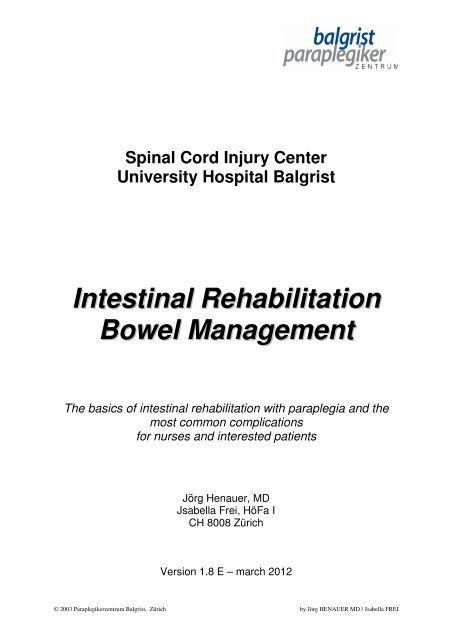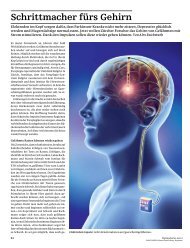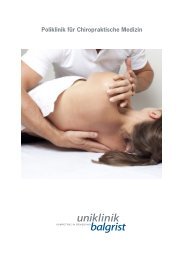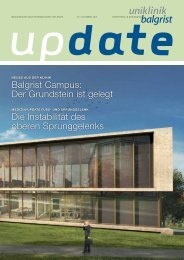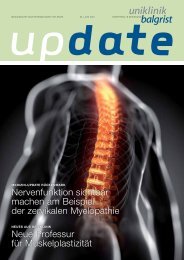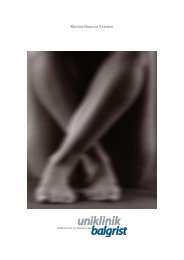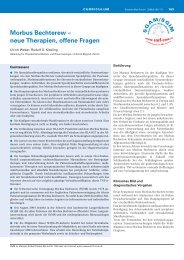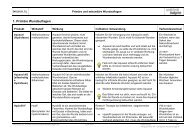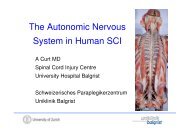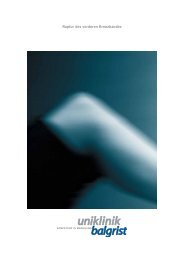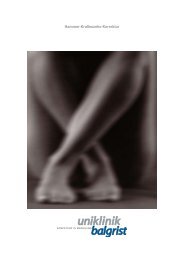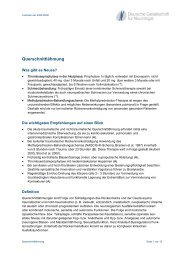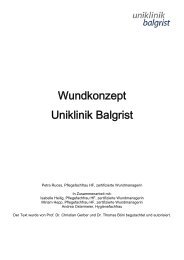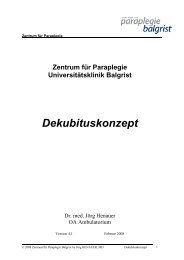Intestinal Rehabilitation 1
Intestinal Rehabilitation 1
Intestinal Rehabilitation 1
Create successful ePaper yourself
Turn your PDF publications into a flip-book with our unique Google optimized e-Paper software.
Spinal Cord Injury Center<br />
University Hospital Balgrist<br />
<strong>Intestinal</strong> <strong>Rehabilitation</strong><br />
Bowel Management<br />
The basics of intestinal rehabilitation with paraplegia and the<br />
most common complications<br />
for nurses and interested patients<br />
Jörg Henauer, MD<br />
Jsabella Frei, HöFa I<br />
CH 8008 Zürich<br />
Version 1.8 E – march 2012<br />
© 2003 Paraplegikerzentrum Balgrist, Zürich by Jörg HENAUER MD / Jsabella FREI
Spinal Cord Injury Center<br />
1. HEALTHY BOWEL FUNCTION / CONTINENT INTESTINE ........................................................... 2<br />
2. BOWEL FUNCTION AFTER SPINAL CORD INJURY ....................................................................... 2<br />
3. COMPLICATIONS .................................................................................................................................... 3<br />
3.1. OBSTIPATION:.............................................................................................................................................. 3<br />
3.2. FLATULENCE (METEORISM):....................................................................................................................... 4<br />
3.3. DIARRHOEA (DIARRHOEA / PARADOXICAL DIARRHOEA):.......................................................................... 4<br />
3.4. BLOOD LOSS: ............................................................................................................................................... 5<br />
4. PRACTICAL APPLICATION OF INTESTINAL REHABILITATION .............................................. 5<br />
4.1. DEFECATION IN SPINAL SHOCK:.................................................................................................................. 5<br />
4.2. PRACTICAL APPROACH AFTER THE ACUTE PHASE:.................................................................................... 5<br />
4.2.1. INTESTINAL TRAINING: ............................................................................................................................ 6<br />
5. AUXILIARY SUBSTANCES FOR BOWEL MOVEMENT / INFLUENCE ON STOOL<br />
CONSISTENCY.................................................................................................................................................... 7<br />
5.1. ORAL LAXATIVES (PURGATIVES FOR INTAKE): .......................................................................................... 7<br />
5.2. RECTAL LAXATIVES: SUPPOSITORIES AND ENEMAS .................................................................................. 7<br />
5.4. BULKING- AND FIBRE AGENTS: ................................................................................................................... 8<br />
6. APPENDIX................................................................................................................................................... 9<br />
6.1. ORAL LAXATIVES ........................................................................................................................................ 9<br />
6.2. RECTAL LAXATIVES: SUPPOSITORIES, ENEMAS....................................................................................... 10<br />
6.3. INTENSIVE LAXATIVES (PURGATIVES), FOR SINGLE USE .......................................................................... 11<br />
6.4. BULKING- / FIBRE AGENTS (EXAMPLES).................................................................................................... 11<br />
© 2003 Paraplegikerzentrum Balgrist, Zürich by Jörg HENAUER MD / Jsabella FREI <strong>Intestinal</strong> <strong>Rehabilitation</strong> Page 1
Spinal Cord Injury Center<br />
1. Healthy bowel function / continent intestine<br />
Stool continence is ensured by a permanent contraction of the involuntarily innervated smooth<br />
inner and striated outer muscles of the anal sphincter.<br />
The filling of the stool in the rectum causes a dilation of the intestinal wall and amplification<br />
of peristalsis occurs through ascending impulses in the plexus myentericus of the intestinal<br />
wall, which transports the content of the intestine further toward the anus. As soon as<br />
peristalsis reaches the anus the inner sphincter becomes limp. Additionally, a significant<br />
increase of peristalsis is achieved by the stimulation of the nerve fibres in the rectum via the<br />
sacral cord and parasympathetic fibres. Furthermore, impulses conducted along the spinal<br />
cord cause an increase in tension and in intra-abdominal pressure. A voluntary relaxation of<br />
the external anal sphincter, the musculature of the pelvic floor and possible additional<br />
abdominal pressure finally set off the evacuation of the stool.<br />
2. Bowel function after spinal cord injury<br />
Damage to the spinal cord has an overall influence on the bowel function regarding the ability<br />
to control stool continence.<br />
In the case of spinal cord injury above the sacral cord the defecation reflex is preserved. The<br />
urge is either strongly reduced or eliminated. Since the control of the smooth internal<br />
sphincter is detoriorated, the emptying of the lower bowel is not anymore voluntarily.<br />
© 2003 Paraplegikerzentrum Balgrist, Zürich by Jörg HENAUER MD / Jsabella FREI <strong>Intestinal</strong> <strong>Rehabilitation</strong> Page 2
Spinal Cord Injury Center<br />
In the case of upper motor neuron paralysis (i.e., above Th11) the state of tension of the<br />
smooth internal sphincter can be significantly increased to a spastic level. In the case of<br />
lower motor neuron paralysis (i.e., below L1) sphincter muscles are limp, which indicates<br />
constant dilation.<br />
3. Complications<br />
3.1. Obstipation:<br />
Obstipation (constipation) can occur for various reasons:<br />
Irregular or non-existent stool scheme<br />
Chronicle incomplete stool evacuation<br />
Irregular eating habits<br />
Decrease in fluid intake or increase in fluid deficit<br />
Changes in daily routine<br />
Intake of drugs which reduce intestinal activity<br />
Lack of physical activity<br />
Occasionally, this is also intentionally caused by patients’ fears of unpleasant incidents.<br />
The consequences are flatulence, pain, discomfort, obstipation and unwanted leakage of stool,<br />
possible increased spasticity, and/or a disturbance of the reflexive function of the bladder.<br />
Especially in quadriplegics, a loss of appetite and breathing problems (shortness of breath)<br />
may additionally appear.<br />
Therapy:<br />
Depending on the examination and additional diagnostic procedures (X-ray) done by the<br />
physician, stronger purgatives (e.g. X-Prep®, Fordtran) are prescribed. During the laxative<br />
procedure cardiovascular parameters especially in quadriplegics patients should be closely<br />
monitored because of the possibility of electrolyte losses. Afterward the current diet and<br />
respectively the concept of defecation must be inspected and possibly modified.<br />
© 2003 Paraplegikerzentrum Balgrist, Zürich by Jörg HENAUER MD / Jsabella FREI <strong>Intestinal</strong> <strong>Rehabilitation</strong> Page 3
Spinal Cord Injury Center<br />
In recurrent or chronic obstipation, particularly for quadriplegics, Colon Hydrotherapy<br />
(colonic irrigation) may serve as an elegant and occasional applied gentle therapy.<br />
Concurrently, a change in nutrition to a fibre-enriched diet is indicated (see information<br />
sheet).<br />
3.2. Flatulence (meteorism):<br />
This occurs most often in connection with obstipation or excessive intake of flatulent foods,<br />
especially carbonated beverages.<br />
Therapy:<br />
In addition to an inspection of the diet- and defecation concept, medicinally supported<br />
purging may be indicated.<br />
Preventatively, a thorough bowel massage should be regularly performed during defecation<br />
(see below).<br />
Experience shows that further along treatment, tea preparations with anise, fennel and cumin<br />
or an equivalent intake in tablet form (Flatulex®) are helpful. As a promising alternative we<br />
are currently using Imogas forte® on a trial basis.<br />
3.3. Diarrhoea (diarrhoea / paradoxical diarrhoea):<br />
A diarrhoeal episode (more than 3 unformed, watery-pulpy stools per day) with consequent<br />
stool incontinence for paraplegics always results in a socially unacceptable condition; in many<br />
cases, especially for quadriplegics, it is a rather dangerous situation. – A circulatory collapse<br />
can quickly occur due to the high loss of fluid if not enough fluid is supplied. Consequently,<br />
close monitoring by nursing staff is required.<br />
Diarrhoea that lasts for several days must be evaluated by a physician to determine the cause<br />
and to be treated accordingly.<br />
Paradoxical diarrhoea is a special type of diarrhoea. Repeated incomplete defecation leads<br />
to a progressive backlog of faecal masses in the large intestine.<br />
The stool is thickened and increasingly hardened by the loss of fluid. This leads to local<br />
irritation of the intestinal wall with strong intestinal juice secretion. As a result, the increased<br />
intestinal peristalsis spasmodically presses inviscid, foul-smelling stool over the hard faecal<br />
masses of the heavily congested rectum. - Smaller amounts lead to constant disposal (faecal<br />
smearing); larger amounts lead to reflexive, uncontrolled evacuations of pulp- to mucous-like<br />
material.<br />
Without knowledge of the causes, paradoxical diarrhoea may be incorrectly diagnosed and<br />
treated as banal diarrhoea, which aggravates the situation.<br />
X-rays are necessary to accurately diagnose paradoxical diarrhoea.<br />
With regard to therapy, the patient’s bowels must be intensively purged (but under no<br />
circumstances with Imodium®!).<br />
© 2003 Paraplegikerzentrum Balgrist, Zürich by Jörg HENAUER MD / Jsabella FREI <strong>Intestinal</strong> <strong>Rehabilitation</strong> Page 4
Spinal Cord Injury Center<br />
3.4. Blood loss:<br />
Occasionally, patients report frightening incidences of blood loss from the colon. Most cases<br />
are due to small mucosal lesions (fissures) which arise from careless manipulation during<br />
manual removal or more rarely due to pinched haemorrhoids. Mucosal lesions can be avoided<br />
by the use of sufficient lubrication, latex gloves (thin plastic gloves with rough seams mean<br />
risk of injury!) and a gentle approach during manual removal.<br />
In the case of repeated blood loss, the cause should be further clarified by a physician.<br />
4. Practical application of intestinal rehabilitation<br />
Objectives of rehabilitation:<br />
• Achievement of a regular, balanced bowel function and defecation<br />
• Avoidance of constipation and diarrhoea<br />
• Defecation daily or every other day and at the same time of the day<br />
• If necessary, the patient is able to independently insert a suppository<br />
• The patient is familiar with the purgatives and their effects<br />
• The patient understands the impact of food on the consistency of stool<br />
• The patient can independently clean him-/herself after defecation:<br />
- In bed<br />
- In the shower chair<br />
- On the toilet<br />
• The patient can assess his/her defecation (colour, consistency, quantity)<br />
4.1. Defecation in spinal shock:<br />
In the acute phase of spinal cord injury with spinal shock, transient ileus (intestinal<br />
obstruction) may occur, which requires the use of parasympathomimetics (e.g. Prostigmin®<br />
or Bepanthen® infusions).<br />
Defecation is carried out through regular manual removal.<br />
Subsequently, the peristalsis and the intestinal activity will (at least in part) recover again.<br />
4.2. Practical approach after the acute phase:<br />
1. Prontolax® supp. daily + oral laxatives (e.g. Movicol® 1 – 2 sachets in the evening).<br />
2. Bowel function well adjusted: possible change to Lecicarbon® supp.<br />
3. Stability in bowel function: determine days for bowel emptying to a daily or every<br />
other day basis.<br />
© 2003 Paraplegikerzentrum Balgrist, Zürich by Jörg HENAUER MD / Jsabella FREI <strong>Intestinal</strong> <strong>Rehabilitation</strong> Page 5
Spinal Cord Injury Center<br />
Oral intake of laxatives (e.g. Movicol®, Feigensirup® etc.) or bulking- and fibre agents (e.g.<br />
Mucilar® Avena, wheat bran, etc.) must be adjusted for each individual patient.<br />
Not every patient reacts in the same way to an individual substance!!<br />
Pay attention to the retardation in time until the effect takes place (12 hours to several<br />
days)!!<br />
Purgatives are taken each night before the desired defecation. With good response during<br />
further course an initially higher dose can be slightly reduced.<br />
4.2.1. <strong>Intestinal</strong> training:<br />
Through intestinal training the voluntary control of defecation through the urge for emptying<br />
the bowels will be replaced by a fixed, precise schedule (1 – 2 daily defecations; at the same<br />
time(s) each day, ideally after a main meal). By consistently following the schedule, regular<br />
emptying of the bowels can be “trained.” Any change in the established program with respect<br />
to diet, fluid intake, or intake of certain drugs (e.g. morphine preparations) ultimately leads to<br />
a loss of control of bowel movements and consequently to unpleasant accidents.<br />
The evacuation should be carried out stress free, undisturbed and planned with sufficient time.<br />
Defecation takes place in a relaxed seated position when done on a toilet seat or in a shower<br />
chair. If the evacuation occurs in bed, a left lateral position should be taken due to anatomical<br />
rationale.<br />
To support the intestinal passage, i.e. defecation, a massage of the intestine is useful. This<br />
follows the normal track of the colon: beginning in the right lower abdomen of the patient,<br />
the massage follows the ascending portion of the colon (ascending colon), the transverse<br />
(transverse colon) and the descending portion (descending colon) to the sigmoid.<br />
To support defecation a massage of the descending portion is especially suitable. It should<br />
therefore be carried out consistently and during defecation.<br />
Movement of intestinal contents by peristalsis<br />
The evacuation reflex is triggered by local irritation, either by a suppository or by stretching<br />
the sphincter with a gloved finger (with a circular motion).<br />
© 2003 Paraplegikerzentrum Balgrist, Zürich by Jörg HENAUER MD / Jsabella FREI <strong>Intestinal</strong> <strong>Rehabilitation</strong> Page 6
Spinal Cord Injury Center<br />
In the absence of the evacuation reflex the mucous membrane and an extensively gentle<br />
manual removal of the sphincter is indicated.<br />
A change in diet to one which is balanced and high in fibre, together with sufficient fluid<br />
intake (2 to up to 3 litres per day), is of great importance for the composition and shape of the<br />
stool (see also information sheet on “Fibre-rich Diet”).<br />
In very special cases of prolonged diarrhoea and incontinence caused by a flaccid anal<br />
sphincter, the use of a dietary supplement has recently proved successful. The product is<br />
Stimulance®, whose practical application is described in detail in Appendix 6.5. In general,<br />
normalisation of stool consistency is achieved with one packet.<br />
5. Auxiliary substances for bowel movement / influence on stool<br />
consistency<br />
Note: Some drugs are usually not part of the comprehensive coverage of health insurance!<br />
For further detailed information on individual effects, side effects, etc. see Appendix.<br />
5.1. Oral laxatives (purgatives for intake):<br />
With regular ingestion a soft, smooth bowel movement should be achieved through the<br />
storage of fluid. To some extent an improvement in peristalsis (bowel movement) can be<br />
expected. The effect of the preparations usually occurs from 12 hours to several days later<br />
(depending on the individual time of passage).<br />
Suitable for daily use are<br />
E.g.: Importal®, Movicol®, fig syrup, etc.<br />
5.2. Rectal laxatives: suppositories and enemas<br />
In principle, there are 3 different types of effects among suppositories:<br />
• Improvement of the lubricity of the stool (e.g. Bulboid®)<br />
• Activation of the strain stimulus, formation of CO2 (e.g. Lecicarbon®)<br />
• Local irritation of the mucous membrane (e.g. Prontolax®)<br />
The suppositories are to be inserted as deeply as possible. An effect can be expected after<br />
approximately 30 to 60 minutes.<br />
A special group of laxatives serves as preparations for use as an enema. Consequently, the<br />
softened stool in the rectum and sigmoid colon empties within 5 to 20 minutes.<br />
E.g.: Microklist®, Clyssie® etc.<br />
© 2003 Paraplegikerzentrum Balgrist, Zürich by Jörg HENAUER MD / Jsabella FREI <strong>Intestinal</strong> <strong>Rehabilitation</strong> Page 7
Spinal Cord Injury Center<br />
5.3. Intensive acting laxatives (purgatives):<br />
These are preparations with an intense effect, which each have a one-time-only application in<br />
pronounced constipation. Due to potentially harmful side effects (circulatory problems) and<br />
contraindications (intestinal obstruction) they should be prescribed by a physician. In<br />
particular, blood pressure changes during application in quadriplegic patients should be<br />
monitored.<br />
E.g.: X–Prep®<br />
5.4. Bulking- and fibre agents:<br />
With simultaneous intake of fluid, these cause increases in quantity and volume of faecal<br />
matter through their swelling capacity and thus an improvement in peristalsis. Particularly<br />
early in treatment, this can lead to an increased development of gas. The amount and<br />
frequency of intake must be tailored to each patient.<br />
E.g.: Mucilar® Avena, wheat bran, etc.<br />
Fibre-rich foods and dietary supplements such as wheat bran and flax seeds in various forms<br />
© 2003 Paraplegikerzentrum Balgrist, Zürich by Jörg HENAUER MD / Jsabella FREI <strong>Intestinal</strong> <strong>Rehabilitation</strong> Page 8
Spinal Cord Injury Center<br />
6. Appendix<br />
Preparation Effect Effect Side effects<br />
Dosage after<br />
6.1. Oral Laxatives<br />
Duphalac® Syrup / Dry<br />
2 x 15 – 30 ml<br />
2 x 10 – 30 g<br />
Feigensirup® fig syrup<br />
2 x 15 – 30 ml<br />
Importal® Sachet<br />
1 x 1 – 2 Sachets<br />
Prontolax ® Dragée<br />
1 – 2 dragée / day<br />
Transipeg forte® Packet<br />
1 – 2 packets / day<br />
in 100 ml water<br />
Preparations in italics = not covered by health insurance<br />
Osmotic laxative – poorly soluble sugars are<br />
degraded to amino acids in the colon →<br />
increase in osmotic pressure, increased<br />
stool volume, improved peristalsis.<br />
Laxative effect in the large intestine through<br />
mucous substances, fruit sugar and fruit acid.<br />
Osmotic laxative – for effects, see above.<br />
Contact laxative. Increase in intestinal peristalsis.<br />
Iso-osmotic laxative effect<br />
Through binding of water, larger volume, intestinal<br />
walls are stretched, defecation stimulus is triggered.<br />
12 – 48 h<br />
over 24 h<br />
12 – 48 h<br />
10 – 12 h<br />
24 – 48 h<br />
© 2003 Paraplegikerzentrum Balgrist, Zürich by Jörg HENAUER MD / Jsabella FREI <strong>Intestinal</strong> <strong>Rehabilitation</strong> Page 9<br />
At onset: meteorism, diarrhoea.<br />
<strong>Intestinal</strong> irritation, meteorism.<br />
At onset: meteorism,<br />
abdominal cramps, possibly nausea.<br />
Abdominal cramps, meteorism,<br />
diarrhoea – loss of water and potassium, d<br />
to mucous membrane.<br />
Diarrhoea, vomiting, abdominal pain.
Spinal Cord Injury Center<br />
Preparation Effect Effect Side effects<br />
Dosage after<br />
Movicol ® Sachet<br />
1 x 1-2 packets/day<br />
in 125 ml water<br />
6.2. Rectal laxatives: suppositories, enemas<br />
Bulboid Supp.®®®®<br />
1 x 1<br />
Lecicarbon Supp.®®®®<br />
1 x 1 – 2 (moisten with<br />
warm water)<br />
Prontolax Supp.®<br />
1 x 1 - 2<br />
Microklist® Enema<br />
Osmotically acting laxative<br />
In faecal stasis (massive constipation): 8 sachets in<br />
1 L water, within 6 hours.<br />
© 2003 Paraplegikerzentrum Balgrist, Zürich by Jörg HENAUER MD / Jsabella FREI <strong>Intestinal</strong> <strong>Rehabilitation</strong> Page 10<br />
8 -24 h<br />
Onset of effect depending<br />
on severity of constipation<br />
No known side effects.<br />
Glycerine to facilitate the passage. 30 min. Possible irritation of mucous membrane<br />
from prolonged use.<br />
Through production of CO2 – increase of secretion,<br />
reflexive activation of peristalsis.<br />
Contact laxative. – increases peristalsis, inhibits<br />
reabsorption of water-/electrolytes. – Esp. in initial<br />
stage of paralysis.<br />
Saline laxative – softening of stool in rectum /<br />
sigmoid colon.<br />
Clyssie® Enema<br />
Saline Laxative. - Through hypertonic solution<br />
osmotically effective for emptying the sigmoid colon<br />
and rectum.<br />
Preparations in italics = not covered by health insurance<br />
15 – 30 min. Irritation of mucous membrane,<br />
meteorism.<br />
20 – 30 min. Possible damage to intestinal mucous<br />
membrane from long-term use.<br />
5 – 20 min. Mild intestinal spasms.<br />
No habituation.<br />
5 – 20 min. Abdominal pain, cramps, salt loss.
Spinal Cord Injury Center<br />
Preparation Effect Effect Side effects<br />
Dosage after<br />
6.3. Intensive laxatives (purgatives), for single use<br />
X-Prep® Liquid<br />
1/2 – 1 pack<br />
(+ plenty of liquid)<br />
6.4. Bulking- / fibre agents (examples)<br />
Metamucil Regular® Powder<br />
1 – 3 tsp./day<br />
Mucilar® Avena<br />
2 x 1 – 2 scoops<br />
Wheat Bran<br />
1 – 6 tbsp. / day<br />
(2 dl liquid per tbsp.)<br />
Preparations in italics = not covered by health insurance<br />
Increases the release of water into the colon and<br />
strengthens peristalsis.<br />
Herbal intestinal regulator. Through increase in<br />
water absorption increase in stool volume.<br />
Combination of psyllium and oat bran, with a high,<br />
constant bulking factor.<br />
With sufficient liquid intake – swells up in the<br />
intestine, whereby the intestinal volume and the<br />
peristalsis become increased.<br />
© 2003 Paraplegikerzentrum Balgrist, Zürich by Jörg HENAUER MD / Jsabella FREI <strong>Intestinal</strong> <strong>Rehabilitation</strong> Page 11<br />
5 – 8 h Severe intestinal spasms may be<br />
avoided with proper fluid intake.<br />
12 – 48 h Meteorism, bloating; in rare cases<br />
allergic reaction.<br />
Day/Weeks<br />
Days/Weeks<br />
At onset: meteorism.<br />
At onset: meteorism.
Spinal Cord Injury Center<br />
6.5. Nutritional Supplements<br />
Stimulance Multi Fibre Mix®<br />
Application:<br />
Day 1: Start with dissolving 1 scoop (12.6 g powder) of Stimulance in 20 ml hot water – then add to any desired liquid (may also be cold).<br />
Day 2+3: See Day 1.<br />
Day 4: Dissolve 2x1 scoops of Stimulance and add to any desired liquid.<br />
Administer 1 dose in the morning, 1 dose in the evening.<br />
Day 5+6: See Day 4.<br />
From Day 7: Dissolve 3x1 scoops of Stimulance and add to any desired liquid.<br />
Take 1 dose with each main meal.<br />
Normally, with 3-4 scoops of Stimulance per day stool consistency and frequency should improve and become more regular over time.<br />
1 scoop of Stimulance (12.6 g powder) contains 5 g dietary fibre.<br />
Preparations in italics = not covered by health insurance<br />
© 2003 Paraplegikerzentrum Balgrist, Zürich by Jörg HENAUER MD / Jsabella FREI <strong>Intestinal</strong> <strong>Rehabilitation</strong> Page 12


